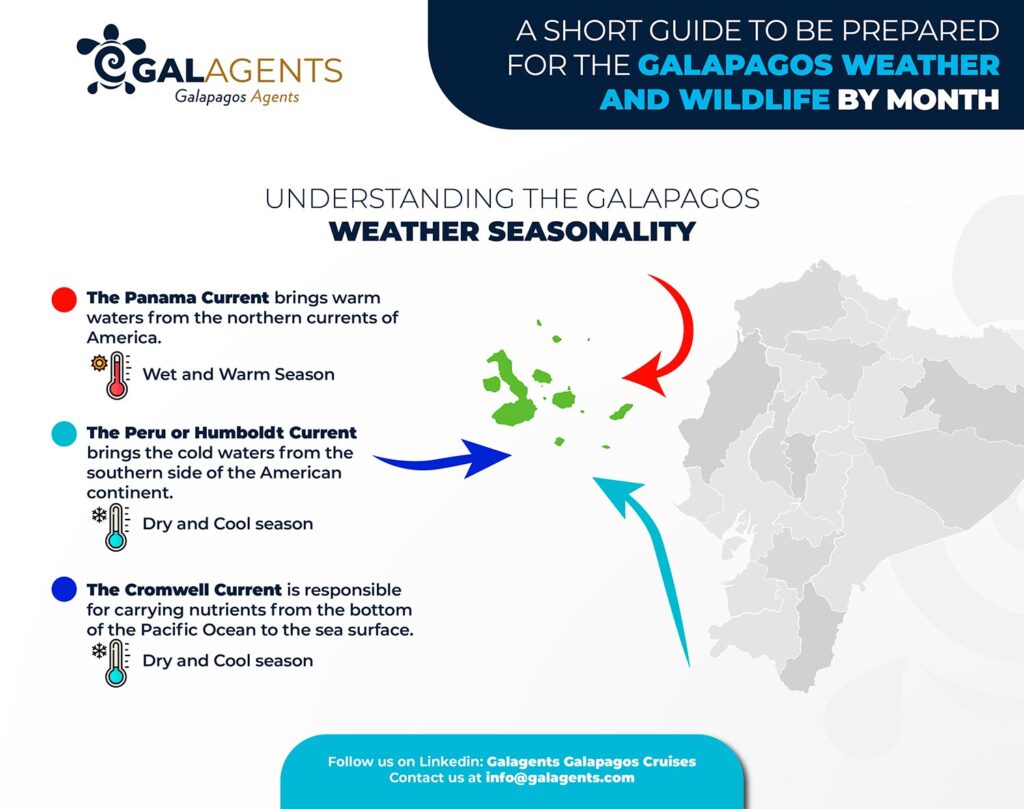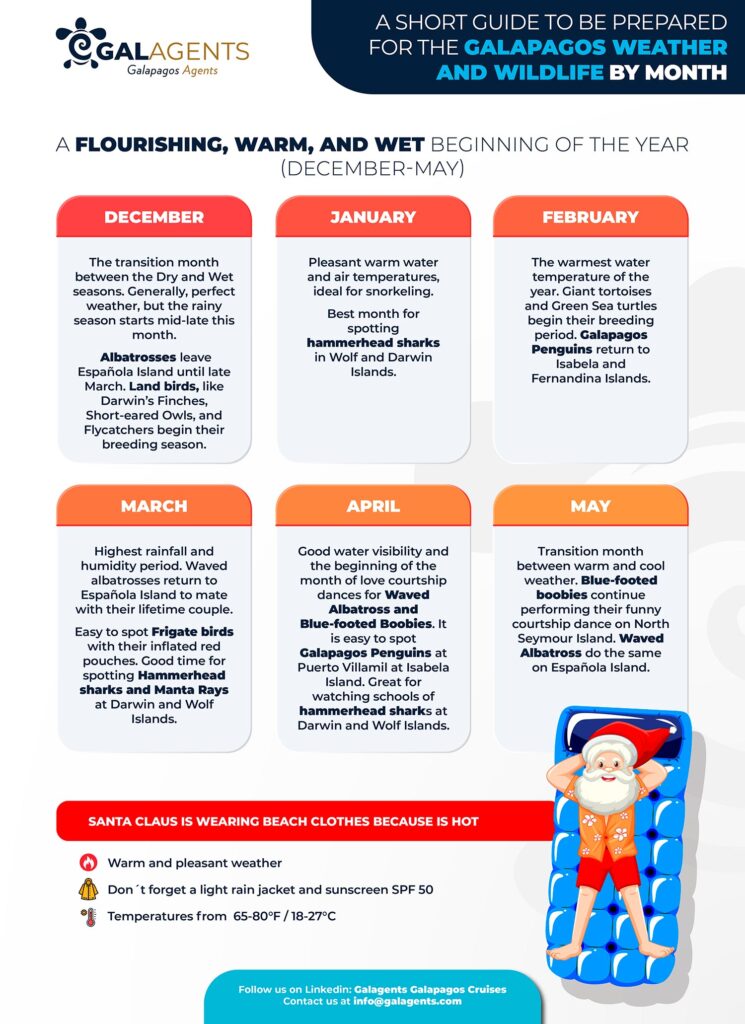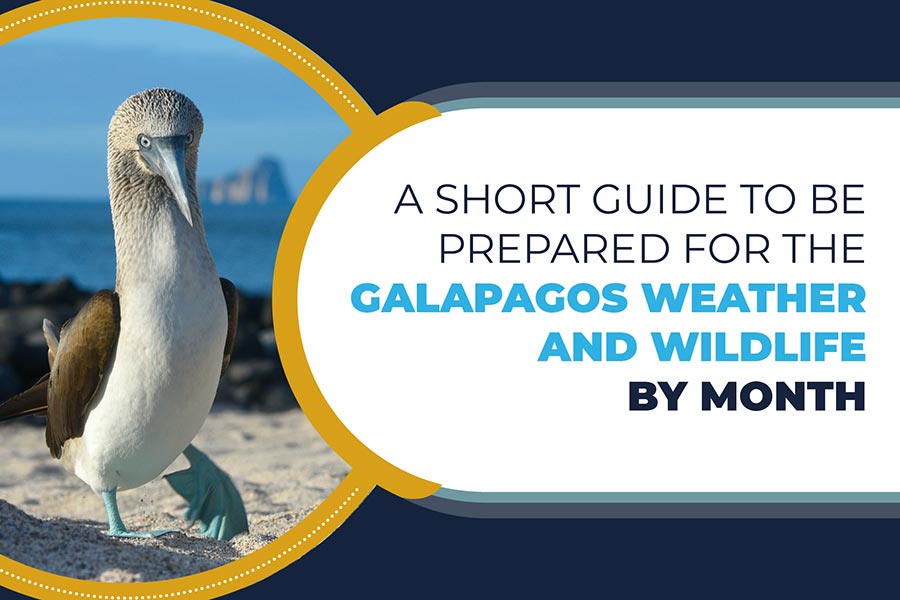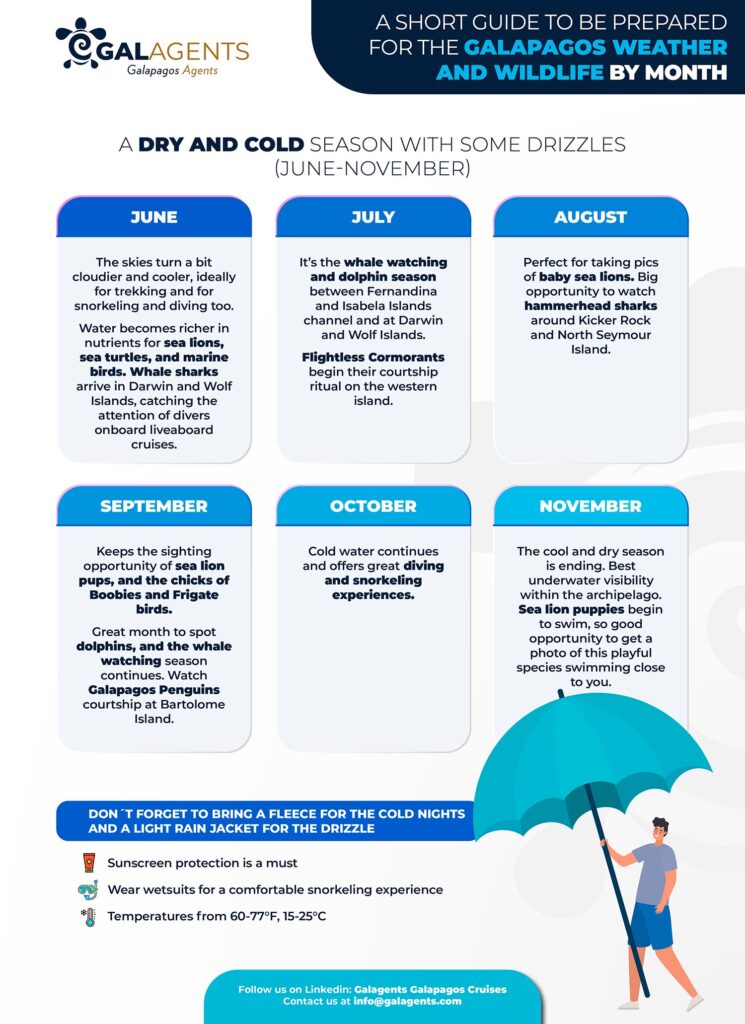One of the most frequent questions that travelers have before traveling to their dream destination is about the weather and the best time for visiting it—our responsibility as travel advisors and tour businesses is to offer accurate information and bits of advice about it.
Therefore, we decided to explain the tips and tricks about the Galapagos weather and wildlife behavior.
Understanding the Galapagos weather seasonality
The Galapagos Islands have only two seasons (rainy and dry). But is there any limitation to travel to the Galapagos in any of these seasons? Fortunately, there are not. Indeed, travelers can visit the Galapagos Islands all year round and experience a wide range of natural and wildlife experiences. However, there are many considerations when planning a trip to Galapagos.
The first thing to have in mind is that the Galapagos Islands converge three ocean currents that significantly influence the weather in the archipelago
- The Panama Current brings warm waters from the northern currents of America.
- The Peru or Humboldt Current brings the cold waters from the southern side of the American continent.
- The Cromwell Current is responsible for carrying nutrients from the bottom of the Pacific Ocean to the sea surface.

Each one influences the temperatures on land and underwater, affecting wildlife behavior.
A flourishing, warm, and wet beginning of the year
Aside from what North Americans and Europeans are used to, the Galapagos Islands give travelers warm water and pleasant weather from December to May.
Remember, even though the Galapagos archipelago is right in the Equator line, it’s influenced by the South American seasons, meaning that Santa Claus is wearing beach clothes during Christmas instead of the polar attire.
However, being warm doesn’t mean that it is not possible to experience some heavy rains. So, recommending including a light rain jacket on the packing list is a must.
Is it too hot in Galapagos during the warm-rainy season? Not at all!
Expect temperatures ranging from 65-80°F / 18-27°C but using a sunscreen cream is a must. So, never forget to add to the packing list and sunblock with SPF 50 minimum.

What can travelers expect to experience in Galapagos during the rainy season?
December: It’s the transition month between the Dry and Wet seasons. Generally, perfect weather, but the rainy season starts mid-late this month. Albatrosses leave Española Island until late March. Land birds, like Darwin’s Finches, Short-eared Owls, and Flycatchers begin their breeding season.
January: Pleasant warm water and air temperatures, ideal for snorkeling. Marine iguanas turn their green and red color brighter to begin their mating season. This is the best month for spotting hammerhead sharks in Wolf and Darwin Islands onboard a liveaboard cruise.
February: The warmest water temperature of the year. Rain helps the highlands vegetation turn green, which is excellent for Giant tortoises and Green Sea turtles for breeding. Marine iguanas begin to lay their eggs, and males become more territorial. Galapagos Penguins return to Isabela and Fernandina Islands, sharing the site with Flightless Cormorant chicks.
March: Highest rainfall and humidity period. Waved albatrosses return to Española Island to mate with their lifetime couple. Easy to spot Frigate birds with their inflated red pouches. Good time for spotting Hammerhead sharks and Manta Rays at Darwin and Wolf Islands.
April: Good water visibility and the beginning of the month of love courtship dances for Waved Albatross and Blue-footed Boobies. It is easy to spot Galapagos Penguins at Puerto Villamil at Isabela Island. It’s common to watch Galapagos Hawks and Frigate birds flying over Green Sea Turtles and Marine Iguanas nesting sites and hunting their babies. Great for watching schools of hammerhead sharks at Darwin and Wolf Islands.
May: Transition month between warm and cool weather. Blue-footed boobies continue performing their funny courtship dance on North Seymour Island. Waved Albatross do the same on Española Island. Flamingos’ eggs begin to hatch on brackish lagoons.
Remember: This season fits with school spring break in the USA and Canada.
A dry and cold season with some drizzles
Contrary to the American and European summer, the Galapagos Islands are quite sunny with cooler land and sea temperatures. The cold Humboldt and Cromwell currents confluence the archipelago bringing much food for marine wildlife. At the same time, some cold winds bring some drizzles early in the morning.
Expect temperatures ranging from 60-77°F / 15-25°C with some cloudy days.
In terms of what is the weather and wildlife behavior in the Galapagos Islands during the dry and cold season, here are some of the highlights by month:
June: The skies turn a bit cloudier and cooler, ideally for trekking, snorkeling, and diving. Water becomes richer in nutrients for sea lions, sea turtles, and marine birds. Whale sharks arrive in Darwin and Wolf Islands, catching the attention of divers onboard liveaboard cruises. Migratory birds also arrive in Galapagos.
July: The whale watching and dolphin season begin between Fernandina and Isabela Islands channel and at Darwin and Wolf Islands. Waved Albatrosses eggs are hatching at Española Island, and Flightless Cormorants begin their courtship ritual on the western island.
August: Perfect for taking pics of baby sea lions but beware because mothers are very protective. Watch Blue-footed boobies and frigate bird chicks—ample opportunity to watch hammerhead sharks around Kicker Rock and North Seymour Island.
September: Keeps the sighting opportunity of sea lion pups and the chicks of Boobies and Frigate birds. Great month to spot dolphins, and the whale watching season continues. Watch Galapagos Penguins courtship at Bartolome Island.
October: Cold water continues and brings underwater wildlife activity, offering great experiences for divers and snorkeling activities. Galapagos penguin courtship ritual continues on Bartolome Island.
November: The cool and dry season is ending. Best underwater visibility within the archipelago, ideal for divers. Sea lion puppies begin to swim, so it is a good opportunity to get a photo of this playful species swimming close to you.
Hopefully, this information can help travel agents and businesses understand and offer their travelers better advice. There is much more information but let us know which topic you would like us to talk about more in-depth info by leaving your comments. What about Galapagos diving tips and tricks and seasonality?


